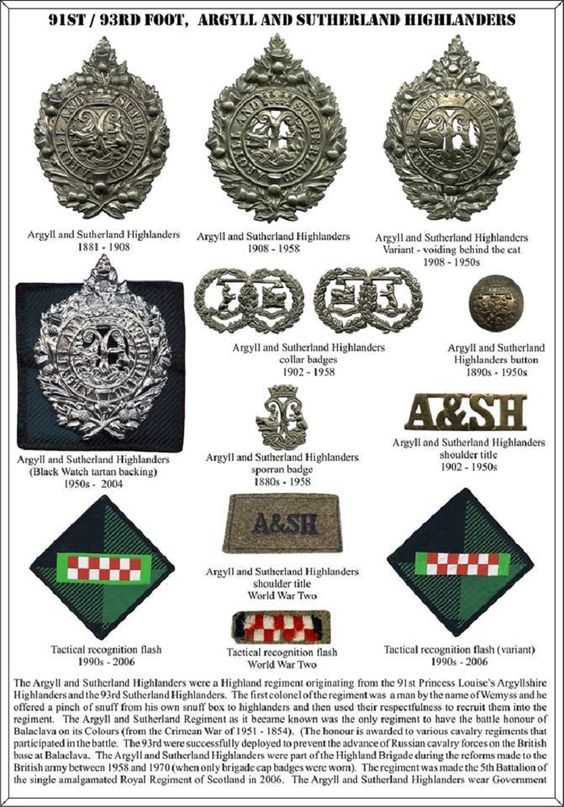Argyll and Sutherland
Highlanders
-
The regiment was created under the Childers Reforms in 1881, as the Princess Louise's (Sutherland and Argyll Highlanders), by the amalgamation of the 91st (Argyllshire Highlanders) Regiment of Foot and 93rd (Sutherland Highlanders) Regiment of Foot, amended the following year to reverse the order of the "Argyll" and "Sutherland" sub-titles.
- 91st (Argyllshire Highlanders) Regiment of Foot
During the Victorian era, the regiment was named the 91st (or Argyllshire) Regiment of Foot in November 1820. It embarked for the West Indies in June 1821 and was garrisoned in Jamaica before returning to England in 1831. Three companies were deployed to Saint Helena in November 1835 and with the exception of one detachment, then sailed on to South Africa in June 1839. The detachment that remained in Saint Helena was tasked with disinterring the body of the late Emperor Napoleon and taking it to Paris.
In April 1842 the regiment formed a reserve battalion. The 1st Battalion took part in various actions in the 7th Xhosa War during 1846 and left South Africa for home in January 1848. Meanwhile, the Reserve Battalion also took part in the 7th Xhosa War during 1846, then saw action against the Boers at the Battle of Boomplaats in August 1848 and went on to fight in the 8th Xhosa War during 1850. The Reserve Battalion left South Africa in July 1855 and continued life in the form of a series of depot companies until being formally disbanded in March 1857.
The 1st Battalion embarked for Malta in December 1854 and for Greece in February 1855 before travelling on to the Ionian Islands in February 1857.
It embarked for Alexandria in September 1858 and took the overground route to India to help suppress the Indian Rebellion. It embarked for England in October 1868. Following the marriage between Princess Louise and John Campbell, Marquis of Lorne at St George's Chapel, Windsor Castle in March 1871, at which the regiment formed a guard of honour.
It was then dispatched to South Africa in February 1879 for service in the Anglo-Zulu war and fought at the Battle of Gingindlovu in April 1879 before lifting the Siege of Eshowe later that month.
- 93rd (Sutherland Highlanders) Regiment of Foot
During Victorian era, the regiment embarked for the West Indies in November 1823. It was based in Barbados until February 1826 when it moved to Antigua and Saint Kitts. It embarked for home again in April 1834. New colours were presented to the regiment by the Duke of Wellington in October 1834. The regiment then moved to Dublin in October 1835.
It embarked to Canada in January 1838 to service in the Patriot War: it landed in Halifax, Nova Scotia in March 1838 and saw action at the Battle of the Windmill in November 1838. It remained in Canada until embarking for home in August 1848.
The regiment arrived at Stirling Castle in October 1848 and provided a Guard of Honour for Queen Victoria on her visit to Glasgow in August 1849.
It embarked for the Crimea for service in the Crimean War in February 1854. As part of Brigadier-General Colin Campbell's Highland Brigade, it took part in the Battle of Alma in September 1854.
On 25 October 1854, it was stationed outside the British-controlled port of Balaklava as part of its very thin defences. The Russian Army sent a large force to attack Balaklava, precipitating the Battle of Balaclava. The Russian threat was countered in part by the charge of General James Scarlett's Heavy Cavalry Brigade but the rest of the Russian force headed straight for the 93rd Regiment of Foot. Campbell told the men of the 93rd Regiment of Foot as he rode down the line: "There is no retreat from here, men...you must die where you stand." One of the troops, John Scott, responded: "Aye, Sir Colin. An needs be, we'll do that." As the younger soldiers moved forward for a bayonet charge, Campbell called out: "93rd, 93rd, damn all that eagerness!" The Times journalist W.H.Russell commenting on the action reported: "The Russians dash at the Highlanders. The ground flies beneath their horses' feet; gathering speed at every stride, they dash on towards that thin red streak topped with a line of steel." This led to the regiment's nickname: "The Thin Red Line". The regiment also took part in the Siege of Sevastopol in June 1855 before embarking for home in June 1856.
The regiment sailed for India in June 1857 to help suppress the Indian Rebellion. It arrived at Calcutta in September 1857 and was welcomed by General Sir Colin Campbell. Under heavy enemy fire, the regiment, together with the 4th Punjab Infantry Regiment took part in the storming and capture of Sikandar Bagh, a walled garden fortification, on 16 November 1857. Six Victoria Crosses were awarded to members of the regiment for their service in this action. At daybreak on 17 November 1857 the Regimental colour was hoisted on top of a tower as a signal to the beleaguered garrison of the Residency at Lucknow. On the night of 19 November 1857 the regiment provided covering fire as the evacuation of the Residency took place. The regiment then saw action again at the Second Battle of Cawnpore in December 1857. The regiment also took part in the storming and capture of Kaiser Bagh in March 1858: a Victoria Cross was awarded to Lieutenant William McBean for his role in killing eleven rebels with his sword during the engagement. It went on to take part in the capture of the city of Bareilly in May 1858 and a skirmish at Russulpore in October 1858. It was renamed the 93rd (Sutherland Highlanders) Regiment of Foot in 1861 before embarking for home in February 1870. The regiment disembarked at Burntisland in March 1870 and received new colours from the Duchess of Sutherland in August 1871. It moved to Curragh Camp in Ireland in May 1877 and to Gibraltar in January 1879.
Formed in 1881, the regiment was one of the six Scottish line infantry regiments, and wears a version of the Government Sett (Government No.2A) as its regimental tartan. It also had the largest cap badge in the British Army. The uniform included the Glengarry as its ceremonial headress.
The 1st Battalion arrived in the Cape in November 1899 and formed part of the 3rd or Highland Brigade. The Argylls played leading roles in the Battle of Modder River, the Battle of Magersfontein, the Battle of Paardeberg and in an action at Roodepoort, immediately preceding the Battle of Doornkop. In June 1900, the battalion was transferred to a new brigade under Brigadier General George Cunningham. They operated around Pretoria and from April 1901, in the Eastern Transvaal. Sections of Argylls formed parts of the 2nd and 12th Battalions Mounted Infantry and a detachment, along with the Black Watch, formed an escort for Captain J E Bearcroft's naval guns during the advance to Pretoria.
.
|
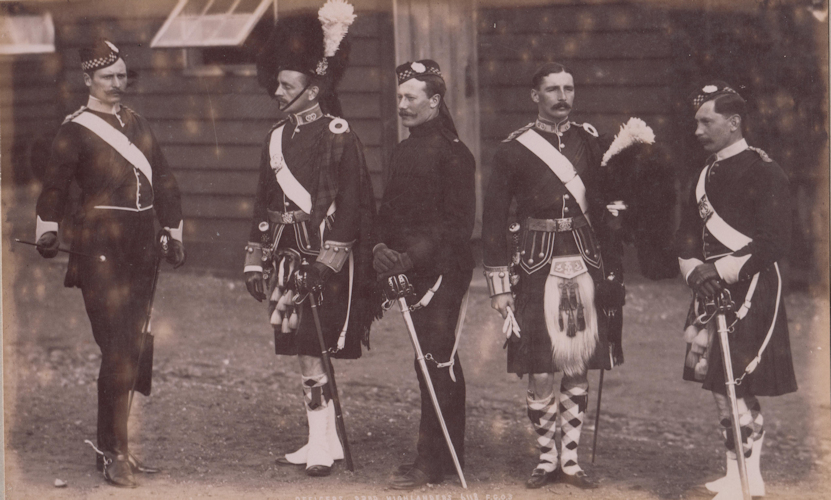
Officers
|
|
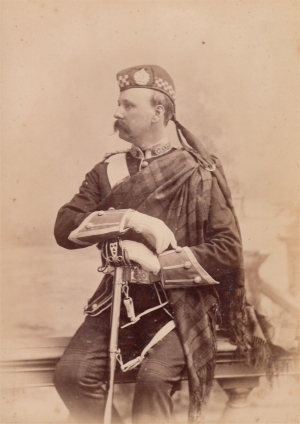
Photo Ramsay
|
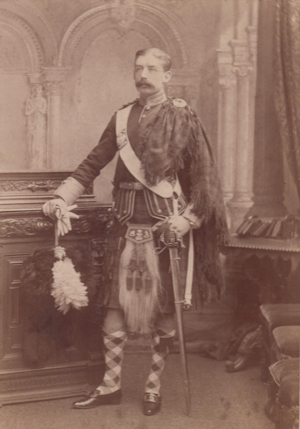
Photo Debenha (Southsea)
|
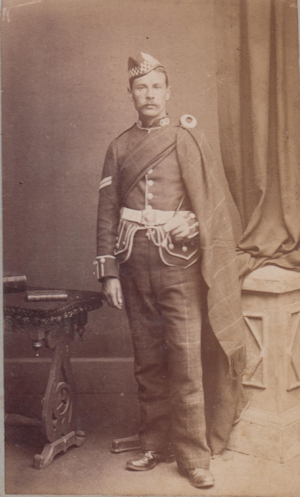
Photo Swanson (Irvine)
|
Retour
